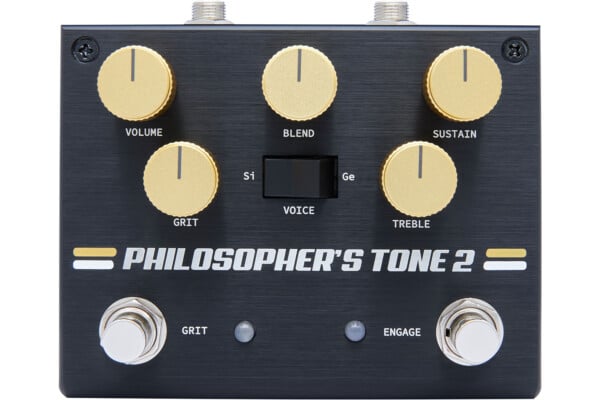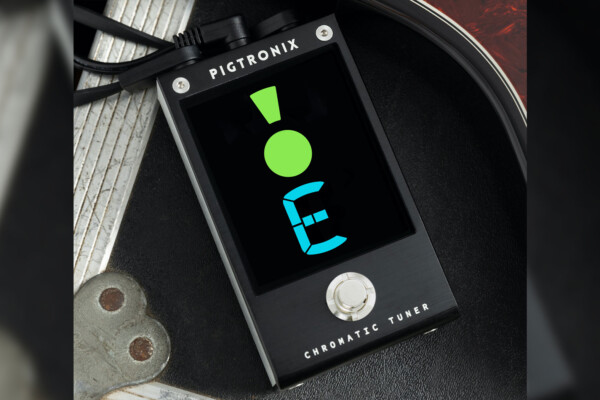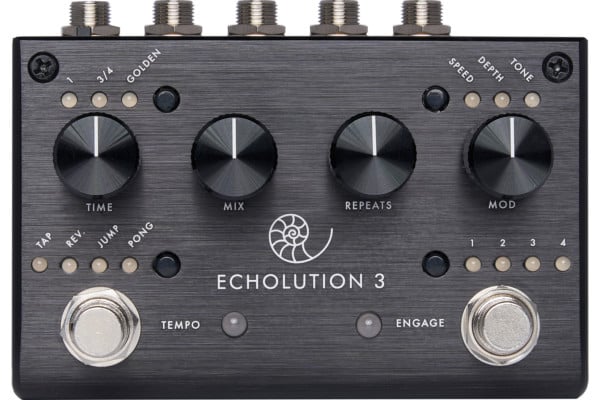Gear Review: Pigtronix EP2 Envelope Phaser
 The EP2 Envelope Phaser is a rework of the Pigtronix’s flagship EP1, which they released six years ago. Though similar in concept, the new model really expands on its sonic capabilities and controls. The pedal, which features true bypass, is a phase shifter that is controlled by an Envelope (EF) or a LFO, giving you either that funky filter based quack or a continuous swirling Univibe sound.
The EP2 Envelope Phaser is a rework of the Pigtronix’s flagship EP1, which they released six years ago. Though similar in concept, the new model really expands on its sonic capabilities and controls. The pedal, which features true bypass, is a phase shifter that is controlled by an Envelope (EF) or a LFO, giving you either that funky filter based quack or a continuous swirling Univibe sound.
Connectivity
The EP2 comes with an 18-volt DC power supply that Pigtronix suggests you use exclusively to avoid any accidents. Besides the normal in and out, the pedal has inputs for an EF Trigger and two inputs for expression pedals to control the Sweep of the Envelope and the Speed of the LFO. Plugging an audio signal into the EF Trigger overrides your bass signal as what controls the Envelope opening and closing. You can plug just about any audio in here, but a kick drum works the best. In such a case the envelope would open for your bass whenever the kick drum hit, which can be a pretty cool effect.
An expression pedal in the Speed Pedal input gives you more stage-friendly access to changing the LFO speed, where the Sweep Pedal input gives you the ability to use an expression pedal as a foot controlled phase-wah. When you use either pedal input, it kills the controls to that parameter on the EP2.
Bells and Whistles
First in the row of knobs on top is Sensitivity, which changes how much signal it takes to open the envelope. When dialed back, you have to really plunk notes out to activate the effect and when turned up the envelope opens with pretty much your every touch. I found myself keeping the sensitivity high, but keeping it lower can really let you accent when you use a stronger attack. The next three knobs, Depth, Center, and Speed control the LFO. Depth relates to the amount of LFO modulation, Center changes where in the audio spectrum the LFO is sweeping, and Speed controls the rate of the LFO. Rounding out the knobs is Resonance, which controls how much feedback is in the circuit. This affects the accentuation of harmonics and gives it more or less of the “vocal” quality.
The row of mini-switches is where the magic happens. First is the extremely useful and funky Staccato switch. Normally the envelope closes gradually, but this switch pretty much acts like a gate on the envelope, quickly closing it when there is space between notes. This may not seem like a big deal, but closing the envelope between every note also means the next note opens the envelope. Therefore, you can articulate every note with the envelope, even in fast funk licks and runs. It also gives extra “oomph” to slap bass, giving every note character. Next is the EF Sweep switch, which changes the direction of the envelope movement, either up or down. Turning the sweep down gives you almost synth-y sounds, and with some tweaking I found some fun techno bass tones. The Blend switch is another neat innovation. It activates the Blend mode, which combines the EF and LFO, and turns the Depth knob into a blend control. Turning it left gives you more Envelope effects, and right gives more LFO. When you mix them the effect gives the initial attack of the Envelope, which then gives way to the LFO sound. This definitely got interesting when playing high chords, which would have a nice attack, then sit and then slowly swirl into a nice ambient feel. When turning on the LFO smooth switch, the resonance is turned way down on the LFO side of the pedal so the peaks are rounded out for a smooth wavy sound. The Invert switch changes the polarity of the phase shifting, either + or -. This is a very tone-altering switch, as the positive polarity acts as bass enhancer, but the negative side has more of a bass cut. Negative gives you a more mid based sound, almost that kind of radio sound. It definitely took me off guard at first, but playing with it some more just made me realize it’s another sound to play with in this box’s arsenal.
In Use
The remarkable thing about this pedal is that you can get so many great sounds without all the confusion. It does take some tinkering to figure out what you want, but all of the controls are neatly laid out and labeled so that you don’t get lost in tons of clutter. Even if it seems like a bit much for you to handle, the owner’s manual is extremely helpful without being verbose and includes a guided walkthrough to get you started on what each knob and switch does. None of the controls are superfluous, and adding them together just builds a new flavor to add to your creativity. The Staccato is really the killer feature in my book, and it stayed on most of the time I played it.
The Pigtronix EP2 Envelope Phaser is a sonically and aesthetically pleasing pedal, with LEDs visualizing what mode you are in and when the pedal is working. The only thing that I would want to change about this pedal is the size of the switches. They are quite small and take a little work to flip them. Otherwise, the EP2 is full of funky, fascinating, and gorgeous sounds that spark creativity.
For more, check out our Gear Watch feature on the Pigtronix EP2 Envelope Phaser.



